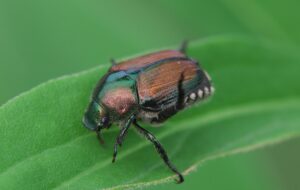 Adults have already been reported by the Wisconsin Pest Bulletin and there is a good chance we will see a significant increase in adults over the next few weeks. A couple of factors come to mind which suggest a higher than normal numbers in 2020. During the 2019 growing season we had adequate soil moisture which will increase egg viability and survival of newly hatch grubs. Furthermore, the mild winter of 2019/2020 should positively influence overwintering survival.
Adults have already been reported by the Wisconsin Pest Bulletin and there is a good chance we will see a significant increase in adults over the next few weeks. A couple of factors come to mind which suggest a higher than normal numbers in 2020. During the 2019 growing season we had adequate soil moisture which will increase egg viability and survival of newly hatch grubs. Furthermore, the mild winter of 2019/2020 should positively influence overwintering survival.
Japanese beetles lay eggs during mid-summer and grubs will be near full grown by the end of summer before they move deeper in the soil profile to overwinter. In the spring grubs will feed, pupate and adults will emerge. Scouting is relatively easy because the adults are large, showy and their damage is easy to find. What is difficult about management is the adults are large, showy and their damage is easy to find. My point is that because the adults and their damage is so noticeable it is easy to get anxious. Just because numbers may be higher DOES NOT mean it will be necessary to spray to control them. It is important to know what the economic thresholds are to determine IF controlling them is needed.
Soybean are more tolerant of defoliation during the vegetative stage; 30% defoliation is needed before an insecticide application can pay for itself. During the reproductive stages that percent defoliation is reduced to 20%. People tend to overestimate defoliation. You can calibrate your estimates by using the chart on the bottom of page 128 in A3646, Pest Management in Wisconsin Field Crops found at https://tinyurl.com/y7nv6px4. Please keep in mind the defoliation threshold is based on the whole plant. Not just the upper leaves where damage is concentrated. I will repeat this, it is important to look at percent defoliation of the entire plant, not just the leaves they have fed on. Another concern about Japanese beetle over management is that soybean aphids and/or two-spotted spider mites may be colonizing fields at the same time. Unnecessary broad-spectrum insecticide application will kill beneficial organisms and increase pest populations quicker than normal.
In corn, a threshold has been established of 3 adults/plant, active silk pruning and feeding prior to 50% of the plants pollinated. Regarding scouting, it is common for people to tell me that populations are higher on the borders of corn fields.
For ornamental plants in the yard their damage is mostly cosmetic, but some homeowners may choose to protect ornamental plants. Several yard and garden insecticides can help control Japanese beetles (read the label) in ornamentals, but they will likely need to be applied a few times due to the length of time Japanese beetles can be prevalent. The traps advertised to control Japanese beetles more often than not attract more beetles to the yard than they catch and UW Extension does not recommend using them.
Japanese beetles can be a major problem to fruit crops. It will likely be time to begin protecting the fruit crops from them soon. Managing Pests in Home Fruit Plantings from Purdue Extension at this link: https://tinyurl.com/h5d2v2n provides a list of insecticides to protect the various fruit crops. If homeowners are looking for organic options, Neem oil is appropriate for organic systems and effective when applied repeatedly. PyGanic is another organically acceptable method for immediate contact control, but the material dissipates quickly if applied during the day. A third organic option is Surround WP (kaolin clay) which deters both Japanese beetle and apple maggots, al-though its efficacy against Japanese beetle is inconsistent. Always read and follow the label for all pesticides.
Written by: Bill Halfman, Extension Monroe County, Agriculture Agent, email: william.halfman@wisc.edu
For more information, please contact: Carolyn Ihde, Agriculture Agent, Extension Richland County by email: carolyn.ihde@wisc.edu




